中国组织工程研究 ›› 2024, Vol. 28 ›› Issue (14): 2234-2241.doi: 10.12307/2024.210
• 组织构建综述 tissue construction review • 上一篇 下一篇
萜类中药单体调控核转录因子κB信号通路防治骨质疏松症的机制
潘成镇,陈 锋,林宗汉,莫 坚,张 驰,韦沅汛,韦宗波
- 广西中医药大学附属瑞康医院,广西壮族自治区南宁市 530011
-
收稿日期:2023-01-28接受日期:2023-03-04出版日期:2024-05-18发布日期:2023-07-28 -
通讯作者:林宗汉,教授、主任医师、硕士生导师,广西中医药大学附属瑞康医院,广西壮族自治区南宁市 530011 -
作者简介:潘成镇,男,1998年生,广西壮族自治区玉林市人,汉族,广西中医药大学在读硕士,主要从事脊柱和骨关节创伤性疾病的防治研究。 -
基金资助:广西自然科学基金项目(2021GXNSFAA220089),项目负责人:陈锋;广西研究生教育创新计划资助项目(YCBZ2021075),项目负责人:张驰;广西中医药大学A类桂派中医药传承创新团队(2022A004),项目参与人:莫坚
Mechanism by which terpenoid herbal monomers prevent osteoporosis by regulating nuclear factor-kappaB signaling pathway
Pan Chengzhen, Chen Feng, Lin Zonghan, Mo Jian, Zhang Chi, Wei Yuanxun, Wei Zongbo
- Ruikang Hospital Affiliated to Guangxi University of Chinese Medicine, Nanning 530011, Guangxi Zhuang Autonomous Region, China
-
Received:2023-01-28Accepted:2023-03-04Online:2024-05-18Published:2023-07-28 -
Contact:Lin Zonghan, Professor, Chief physician, Master’s supervisor, Ruikang Affiliated Hospital, Guangxi University of Chinese Medicine, Nanning 530011, Guangxi Zhuang Autonomous Region, China -
About author:Pan Chengzhen, Master candidate, Ruikang Affiliated Hospital, Guangxi University of Chinese Medicine, Nanning 530011, Guangxi Zhuang Autonomous Region, China -
Supported by:Guangxi Natural Science Foundation, No. 2021GXNSFAA220089 (to CF); Guangxi Postgraduate Education Innovation Program, No. YCBZ2021075 (to ZC); Guangxi University of Traditional Chinese Medicine Class A Guipai Traditional Chinese Medicine Inheritance Innovation Team, No. 2022A004 (to MJ [project participant])
摘要:
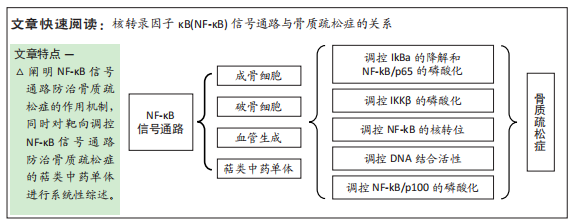
文题释义:
骨质疏松症:是以骨量减少、骨微结构损害导致骨脆性增加的代谢性骨病,其发病机制复杂,多由胃肠道疾病、糖尿病、类风湿性关节炎、衰老、长期使用糖皮质激素治疗、多发性骨髓瘤和其他血液疾病发展而来。核转录因子κB信号通路:该通路能够快速地对外界的各种刺激做出反应,进而调控相关靶基因的表达介导细胞氧化应激、细胞死亡、增殖及炎症反应等生物学过程。目前,已有研究证实核转录因子κB信号通路与骨质疏松症具有紧密的联系,能有效维持人体的骨稳态。
背景:核转录因子κB信号通路在骨质疏松症的发病中扮演着重要的角色。近年来,大量的研究表明萜类中药单体化合物可以通过调控核转录因子κB信号通路,抑制骨吸收细胞的活性,促进骨形成细胞的分化,从而降低骨吸收并增加骨形成,对骨质疏松症具有一定的预防和治疗作用。
目的:通过对国内外文献的分析和总结,深入研究核转录因子κB信号通路与骨质疏松症的关系,并对萜类中药单体化合物调控核转录因子κB信号通路防治骨质疏松症的作用机制进行阐明,同时对靶向调控核转录因子κB信号通路防治骨质疏松的萜类中药单体化合物进行系统性归纳。方法:由2名研究员根据拟定的纳入及排除标准以“NF-κB,骨质疏松症,成骨细胞,破骨细胞,血管生成,中药,萜类化合物”等为检索词检索中国知网数据库,以“NF-κB,osteoporosis,Osteoblasts,Osteoclasts,Angiogenesis,traditional Chinese medicine,terpenoid”等为检索词检索PubMed数据库相关文献,检索时间为建库至2022年12月,再通过第3名研究员对文献进行汇总和整理,最终纳入75篇文献进行系统性综述。
结果与结论:①核转录因子κB信号通路能通过调控成骨细胞、破骨细胞的分化和增殖,以及血管生成,介导骨质疏松症的发病与进展。②核转录因子κB信号通路对成骨细胞的增殖和分化具有负调控的作用,激活核转录因子κB信号通路能增强破骨细胞的活性,抑制成骨细胞的生长,进而抑制代偿骨的生成保持骨稳态,但是过度激活核转录因子κB信号通路则会导致骨质疏松症。③核转录因子κB信号通路通过上调血管生成素1、血小板源性生长因子BB及血管内皮生长因子等细胞因子的表达水平,促进骨内血管生长,参与“血管生成-成骨”偶联。④萜类中药单体化合物在组织工程领域中具有促进骨细胞的增殖和分化,进而促进骨组织生长和修复的作用。⑤萜类中药单体化合物可以通过抑制核转录因子κB抑制蛋白降解,阻断核转录因子κB/P65蛋白磷酸化及核转位等过程,进而减弱核转录因子κB信号通路的传导,促进成骨细胞分化,抑制破骨细胞形成,起到防治骨质疏松的作用。⑥目前,萜类中药单体化合物调控核转录因子κB信号通路防治骨质疏松症的研究主要是基于体外细胞实验和动物模型,对于人体内复杂的生理和病理过程尚缺乏相关研究,未来需要开展更多的临床研究,进一步明确核转录因子κB信号通路参与干预骨质疏松症的作用机制和疗效。
https://orcid.org/0009-0004-5046-3617(潘成镇);https://orcid.org/0009-0009-9861-3238(林宗汉)
中国组织工程研究杂志出版内容重点:组织构建;骨细胞;软骨细胞;细胞培养;成纤维细胞;血管内皮细胞;骨质疏松;组织工程
中图分类号:
引用本文
潘成镇, 陈 锋, 林宗汉, 莫 坚, 张 驰, 韦沅汛, 韦宗波. 萜类中药单体调控核转录因子κB信号通路防治骨质疏松症的机制[J]. 中国组织工程研究, 2024, 28(14): 2234-2241.
Pan Chengzhen, Chen Feng, Lin Zonghan, Mo Jian, Zhang Chi, Wei Yuanxun, Wei Zongbo. Mechanism by which terpenoid herbal monomers prevent osteoporosis by regulating nuclear factor-kappaB signaling pathway[J]. Chinese Journal of Tissue Engineering Research, 2024, 28(14): 2234-2241.
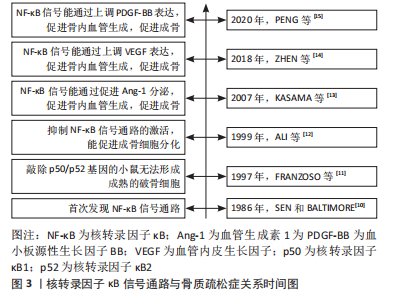
因此,核转录因子κB信号通路在骨代谢和血管生成方面扮演着重要的角色,研究表明阻断核转录因子κB信号通路的激活能够直接减少成熟破骨细胞的形成、促进成骨细胞的分化,同时通过上调血管生成素1、血管内皮生长因子及血小板源性生长因子BB等细胞因子的表达,能促进血管生成,间接促进成骨细胞的分化。这些发现为深入研究骨代谢和血管生成机制提供了重要的理论基础,也为骨质疏松症的治疗提供了新的思路。但是,研究者们仍然需要深入了解核转录因子κB信号通路的调控机制、作用靶点以及与其他信号通路的交叉作用等方面的问题,以期更好地利用和发挥其在临床治疗中的作用。
2.2 核转录因子κB信号通路的组成及激活过程 核转录因子κB家族成员与逆转录病毒癌蛋白v-Rel具有相同的结构特征,共包含RelA(p65),p50,p52,RelB及c-Rel 5个成员,每个成员N端都具有高度保守的Rel同源区(Rel homology region,RHR),在与DNA结合、寡聚化、抑制核转录因子κB抑制蛋白(inhibitor of NF-κB,IκB)和核易位中具有关键作用。成员之间通过相互作用合成一个同源或异源二聚体参与机体相关靶基因的调控[16]。在无刺激的状态下,核转录因子κB二聚体通过与核转录因子κB抑制蛋白相互作用保留在细胞质中,核转录因子κB抑制蛋白具有7个锚蛋白重复序列特征的蛋白,分别是IKBα,IKBβ,IKBγ,IKBζ,IKBε,IKBNS及B细胞淋巴瘤-(3 Bcl-3),都可以通过其C末端特定锚蛋白重复序列蛋白与核转录因子κB结合,阻止核转录因子κB从细胞质进入细胞核[17]。相关研究显示,经典/非经典核转录因子κB信号通路都需要核转录因子κB二聚体参与激活[18]。
经典核转录因子κB通路是指机体损伤、缺氧、细菌病原体、毒性及细胞因子等特定刺激作用于核转录因子κB信号通路,由IKKα,IKKβ和IKKγ构成的IκB激酶(Inhibitor of kappa B kinase,IKK)被激活,导致IKK复合物促进核转录因子κB抑制蛋白磷酸化,进而促使核转录因子κB二聚体(主要由p65、p50和c-Rel亚基组成)从细胞质中移位进细胞核内,在细胞核内通过调控相关基因的表达介导细胞氧化、凋亡、增殖和炎症等生物学过程[8]。非经典核转录因子κB信号通路,当机体受到肿瘤坏死因子受体(tumor necrosis factor receptor,TNFR)家族配体(如肿瘤坏死因子α,β,OX40L及CD40L等)及其他激活因子刺激后,导致相应的受体被激活,进而激活核转录因子κB诱导激酶(NF-κB-inducing kinase,NIK),导致NIK磷酸化和激活IKKα,在此过程中被激活的IKK1促进p52的前体p100磷酸化降解合成p52,在细胞质中的p52与RelB结合成二聚体后进入细胞核,通过对相应靶基因的调节,进而参与多种生物学反应[19]。
目前,关于核转录因子κB信号通路的组成与激活过程的研究已取得一定的成果,但在激活途径方面仍存在一些不足,在某些特定的细胞类型和环境条件下,核转录因子κB信号通路的激活机制可能还没有被完全理解或清楚。此外,核转录因子κB信号通路还可能与其他信号通路存在复杂的交叉调节作用,如JAK/STAT及MAPK等信号通路,这些交叉调节作用可能会增加核转录因子κB信号通路激活的复杂性和不确定性,需要进一步的研究来揭示这些作用。在未来,利用单细胞技术、生物信息学和系统生物学等手段,可以更加全面地分析核转录因子κB信号通路在不同细胞和组织中的功能和调控机制,从而为疾病治疗提供更加精准的策略。
2.3 核转录因子κB信号通路与骨质疏松症的关系
2.3.1 核转录因子κB信号通路对成骨细胞的影响 骨质疏松症是以骨质的吸收为主要特征的疾病,表现为骨质吸收和骨质形成的失衡。成骨细胞是骨形成过程中最重要的一种功能细胞,它的增殖与分化能力对成骨过程起着至关重要的作用[20-21]。有研究表明核转录因子κB信号通路能增强破骨细胞的活性,抑制成骨细胞的生长,能通过抑制代偿骨的生成保持骨稳态[22]。对于核转录因子κB信号通路与成骨细胞的关系可以追塑到1999年,ALI等[12]对人类成骨细胞进行实验,发现肿瘤坏死因子α能以剂量和时间依赖的方式增加核转录因子κB与人类成骨细胞的DNA结合,核转录因子κB信号通路的激活可能是成骨细胞介导的吸收信号传导的重要途径,但他们未提供任何临床试验的证据,这可能会导致对结果的片面报道。
近年来,随着细胞实验和动物实验技术的不断成熟,诸多研究者对核转录因子κB信号通路调控成骨细胞的分化,进而防治骨质疏松症的机制进行了研究。如HE等[23]的研究表明单核素能抑制p65和核转录因子κB/P50蛋白的核易位,阻断核转录因子κB信号通路的激活,进而增加脂多糖损伤的小鼠胚胎成骨细胞前体细胞(MC3T3-E1细胞)中碱性磷酸酶的增殖和活性、骨基质矿化和骨基质蛋白骨桥蛋白的表达,起到预防和治疗炎症性骨质流失的作用。可知促进IkBa的磷酸化、核转录因子κB的核易位,是激活核转录因子κB信号通路的关键步骤。同样的,LIANG等[24]的研究发现在地塞米松处理的小鼠胚胎成骨细胞前体细胞中,地塞米松能通过刺激IkBa的降解和核转录因子κB的核易位,激活核转录因子κB信号通路,使裂解半胱天冬酶3(caspase-3)、半胱天冬酶3显著下调,导致成骨细胞凋亡,而Klotho能逆转这一过程,阻断核转录因子κB信号的激活,起到有效治疗糖皮质激素诱导的骨质疏松症的作用。此外,核转录因子κB/p65蛋白作为核转录因子κB信号通路中的标志性蛋白之一,其表达量的高低常被用来衡量核转录因子κB信号通路的活性,有研究证实了上调核转录因子κB/p65蛋白的表达水平,能激活核转录因子κB信号通路,导致异染色检测碱性磷酸酶、Runt相关的转录因子2(recombinant runt related transcription factor 2,Runx2)和骨钙素等表达水平下调,进而抑制成骨细胞的分化,增加患骨质疏松症的风险[25]。
综上所述,核转录因子κB信号通路对于成骨细胞的增殖和分化具有负调控的作用,通过降低核转录因子κB/p65的表达水平、阻断核转录因子κB/p65核易位、抑制DNA结合活性等途径,可以抑制核转录因子κB信号通过的激活,促进成骨细胞的分化,最终达到防治骨质疏松症的作用。目前关于核转录因子κB信号通路调控成骨细胞分化的机制大多是关于经典核转录因子κB信号通路的研究,对于非经典核转录因子κB信号途径的机制研究较少,未来需要更多的研究证明非经典信号途径与成骨细胞的关系。核转录因子κB信号调控成骨细胞分化的作用机制见表1。
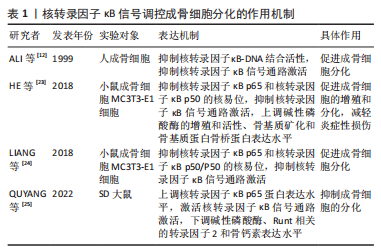
2.3.2 核转录因子κB信号通路对破骨细胞的影响 破骨细胞的源头是骨髓中的单核细胞和巨噬细胞的骨吸收细胞。在经典核转录因子κB信号通路的激活过程中,机体在没有受到刺激的情况下,核转录因子κB二聚体与IκB相互作用存在于细胞质中,当肿瘤坏死因子α、核转录因子受体激活因子κB配体 (receptor activator for nuclear factor-κB ligand,RANKL)等刺激细胞后,激活IKBα激酶,从而致使IKBα的磷酸化或者泛素化,导致核转录因子κB与IKBα分离,随后从细胞质中移位到细胞核内,导致细胞中T细胞核转录因子1蛋白(Nuclear factor of activated t-cells,Cytoplasmic 1,NFATc1)和c-Fos、组织蛋白酶K(CaThepSin K,CTSK)等破骨细胞特异基因表达量增加,最终通过一系列的生物学反应调控破骨细胞的分化和增殖[26-27],其中核转录因子κB受体活化因子配体介导核转录因子κB信号通路的激活研究数量最多。
相关研究显示,RANK募集肿瘤坏死因子受体激活因子(tumor necrosis factor receptor-associated factors,TRAFs)是激活相关信号通路的关键[28]。TRAFs由多个亚型组成,众多亚型中以TRAF2,TRAF3和TRAF6的研究最为普遍。TRAF6的激活是由TRAF6环指区域与数种泛素结合酶形成一条特殊的泛素链,该泛素链可以透过泛素的赖氨酸63链接到相关的激酶,从而介导下游信号通路的活化,例如招募和活化转化生长因子β活化激酶1(TGF-beta-activated kinase 1,TAK1),进而引起IKK/核转录因子κB降解导致经典核转录因子κB信号通路的激活[29]。除此之外,核转录因子κB/p65作为经典核转录因子κB信号通路中的关键蛋白,当具有活性的核转录因子κB/p65与NFATc1启动子在细胞核内结合后,可加速细胞内基因的转录[30]。
同样地,有研究在此基础上发现抑制IKBα降解和核转录因子κB/P65磷酸化,可以阻断核转录因子κB信号通路的传导,进而抑制破骨细胞形成[31-32]。非经典核转录因子κB信号通路主要由肿瘤坏死因子受体TNFR家族配体(如肿瘤坏死因子α、肿瘤坏死因子β、OX40L及CD40L等)、核转录因子κB受体活化因子配体等激活[29],调控核转录因子激活的NFATc1,介导破骨细胞的分化和增殖。有研究显示配体TRAF2,TRAF3和细胞凋亡抑制因子1/2(cellular inhibitors of apoptosis 1 and 2,cIAP1/2)可以激活非经典核转录因子κB信号通路,3者可形成一个复合物,以TRAF3为中心,致使cIAP1/2介导核转录因子κB诱导激酶的K48链接泛素化,进而激活核转录因子κB诱导激酶,最终促进破骨细胞的形成[33-35]。
总之,核转录因子κB信号通路对于破骨细胞的形成具有正向调控作用,当肿瘤坏死因子α、核转录因子κB受体活化因子配体等刺激细胞后,激活核转录因子κB信号通路,上调破骨细胞特异基因(NFATc1,c-Fos,CTSK),促进破骨细胞的分化,最终达到防治骨质疏松症的效果。但现有研究主要是基于体外细胞实验和动物模型,对于人体内复杂的生理、病理过程尚未有明确证据,而且对于核转录因子κB信号通路与其上下游分子的机制研究也还不够深入。总之,核转录因子κB信号通路调控破骨细胞干预骨质疏松的作用机制研究还有许多需要探究的问题,但随着技术和研究手段的不断提高,相信未来将会有更多的突破和发展,为骨质疏松的预防和治疗提供更加有效的手段。核转录因子κB信号调控破骨细胞分化的作用机制,见图4。
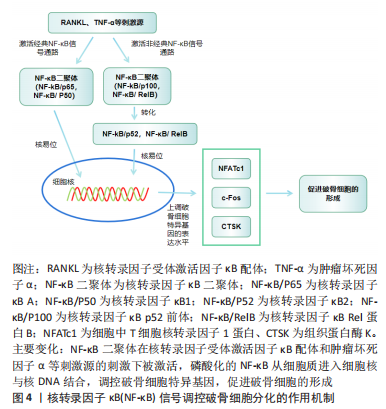
2.3.3 核转录因子κB信号通路对血管生成的影响 血管生成是组织发育、维护和修复过程中的一个重要步骤,与多种疾病的发生和发展密切相关。研究表明血管生成与骨质疏松症之间存在复杂的关系,骨骼组织需要足够的血液供应以获得足够的氧气和营养物质,这对于骨骼的健康至关重要[36]。血管生成素1是一种重要的促血管生成因子,在成骨细胞中的表达对于调节正常和病理生理条件下的骨重塑非常重要,KASAMA等[13]的研究表明人前骨细胞在没有任何刺激的情况下都会自发分泌大量的血管生成素1,而人干扰素γ加肿瘤坏死因子α共同刺激会减少人前骨细胞中血管生成素1的分泌,其机制与激活核转录因子κB信号通路上调一氧化氮表达有关。血管内皮生长因子在骨形成中发挥着重要的作用,其可以刺激骨母细胞、成骨细胞和内皮细胞增殖,促进血管生成和骨组织形成,ZHEN等[14]研究表明表明肝细胞生长因子能增加实验小鼠成骨细胞中p65、IkB β和IkB α的表达,上调血管内皮生长因子、骨形态发生蛋白2 受体、核转录因子κB配体受体激活剂和巨噬细胞集落刺激因子(Macrophage colony stimulating factor,M-CSF)的表达水平,进而促进血管再生、骨的形成和血运重建。
同样地,FAN等[37]利用姜黄素抑制高血糖诱导的核转录因子κB信号通路,发现姜黄素能上调碱性磷酸酶、Runt相关的转录因子2和血管内皮生长因子表达水平,恢复“血管生成-成骨”偶联,达到预防糖尿病性骨质疏松症的效果。血小板源性生长因子BB是一种由血小板、内皮细胞、平滑肌细胞和其他类型的细胞产生的生长因子,有研究表明糖皮质激素能通过减少前骨细胞中血小板源性生长因子BB的产生而破坏骨骼血管的形成,其机制与减少核转录因子κB与血小板源性生长因子BB启动子的结合,导致血小板源性生长因子BB转录减少有关[15]。同样地,LIN等[38]在此基础上通过体内和体外实验,证明了乙酸乙酯能抑制核转录因子受体激活因子κB配体诱导的IκBα和核转录因子κB/p65的磷酸化,减弱核转录因子κB信号通路传导,上调血小板源性生长因子BB表达水平,促进H型血管形成,防止卵巢切除诱导的小鼠骨质流失。
综上,核转录因子κB信号可以通过上调血管生成素1、血小板源性生长因子BB、血管内皮生长因子等细胞因子的表达水平,参与骨再生,血管生成和骨质细胞之间的平衡,起到干预骨质疏松症的作用。目前关于核转录因子κB信号调控相关因子促进“血管生成-成骨”偶联的研究尚不够全面,如碱性成纤维细胞生长因子、轴突导向分子3、低氧诱导转录因子1α等细胞因子也能促进“血管生成-成骨”生成偶联[39],但与核转录因子κB信号的关系研究尚缺乏,未来需要更多的基础实验和临床实验验证核转录因子κB信号通过调控“血管生成-成骨”偶联,进而防治骨质疏松症的机制。核转录因子κB信号调控血管生成的作用机制如表2。
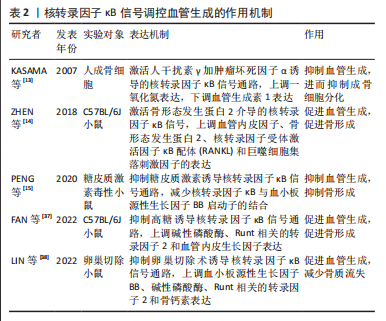
目前,核转录因子κB信号通路在成骨细胞、破骨细胞和血管生成等方面的研究已经取得一定的进展,但仍有一些不足之处:首先,核转录因子κB信号通路在不同类型的骨细胞中具有复杂的作用机制,尚需进一步深入研究;其次,虽然核转录因子κB信号通路在血管生成中发挥着重要作用,但其具体作用机制仍不完全清楚。未来需要建立更为完整的骨细胞信号网络,深入研究核转录因子κB信号通路在骨质疏松方面的作用机制,进一步阐明其在骨代谢调控中的作用和意义。此外,可以借助现代生物技术手段,从多个角度深入探究核转录因子κB信号通路在骨细胞中的作用,为未来骨质疏松症的治疗和预防提供更加有效的策略和手段。
2.4 萜类中药单体调控核转录因子κB信号通路对骨质疏松症的干预 萜类化合物是一种生物源挥发性的有机化合物,可以构成多种不同结构的次生植物代谢产物[40],其结构基于异戊二烯基的连接,能产生各种萜烯类化合物。根据连接的异戊二烯基的数量大小不同,生成的萜烯被分为半萜、单萜、倍半萜、二萜、三萜、四萜和多萜类(C5,C10,C15,C20,C30,C40和C5的长链)[41]。骨组织工程是治疗骨缺损和骨骼疾病的前沿领域之一,萜类化合物由于其天然来源、广泛分布、生物活性多样性和低毒性等特点,越来越受到研究者的关注。
在骨组织工程领域,萜类化合物已被证明具有多种骨生物学特性,如促进成骨细胞和软骨细胞的增殖,上调成骨细胞和软骨细胞的碱性磷酸酶和骨钙素的表达,促进骨基质沉积和钙化等[42]。萜类化合物与传统的合成材料相比,具有特性材料多样、更容易被生物体接受、来源更加广泛等优势。此外,萜类化合物还具有可调节的生物活性,可以通过调整化合物的化学结构来调节其生物活性。虽然萜类化合物在骨组织工程领域具有广阔的应用前景,但也存在着限制和挑战。首先,有些萜类化合物可能存在毒性或不良反应。例如,有研究表明高剂量的人参皂苷化合物K可能导致肝脏和肾脏毒性[43]。部分萜类化合物的生物利用度较低,需要额外的材料来提高生物利用度和稳定性[44],这可能增加药物的成本和潜在的毒性风险。此外,萜类化合物的稳定性也是一个问题,化合物可能在体内被代谢或分解,从而降低它们的生物活性和持续时间[45]。所以,未来的研究应重点关注萜类化合物的毒性和稳定性,以及生物利用度,开发更安全、更有效的治疗药物,为骨组织工程领域的临床实践做出更大的贡献。
核转录因子κB信号通路是一条重要的细胞信号传导通路。在骨组织中,核转录因子κB信号通路也扮演着重要的角色,可以通过调节骨细胞的分化和功能影响骨代谢的平衡。近年来的研究表明多种来源于中药的萜类化合物可以通过调控核转录因子κB信号通路起到防治骨质疏松的作用,虽然目前的研究还处于初级阶段,但已经有许多有前景的发现和进展。因此,文章归纳近年来关于萜类中药单体化合物调控核转录因子κB信号通路防治骨质疏松的研究,为进一步研究和开发具有临床应用前景的防治骨骨质疏松症的药物奠定基础。
2.4.1 单萜类 单萜类化合物一般存在于单子叶和双子叶被子植物、真菌、细菌和裸子植物[41]。芍药苷是由芍药中分离出来的水溶性单萜类化合物。WANG等[46]的研究发现,芍药苷可降低核转录因子κB的活性,阻断核转录因子κB信号的激活,上调碱性磷酸酶、骨钙素、骨保护蛋白和Runx2基因的表达水平,下调NFATc1基因表达水平,抑制破骨细胞形成,促进成骨细胞分化,从而起到预防和治疗骨质疏松症的作用。龙胆苦苷(Gentiopicroside,GPS)是一种来源于北川龙胆的烯醚萜苷类化合物,具有广泛的药理活性,包括护胆、抑制炎症反应和抗氧化应激反应等[47]。CHEN等[48]使用龙胆苦苷干预RANKL诱导的小鼠骨髓巨噬细胞,发现龙胆苦苷可以通过降低核转录因子κB/p65和IKBα的表达,阻断核转录因子κB信号的激活,抑制破骨细胞形成相关标记基因(碱性磷酸酶和Runx2等)的表达,起到抑制RANKL诱导的小鼠巨噬细胞向破骨细胞分化的作用。
2.4.2 倍半萜类 环丙烯酸是从植物萜菜根部提取出来的具有多种生物活性的倍半萜化合物,能起到抗菌、抗肿瘤和抗炎等作用。有研究表明环丙烯酸在RANKL刺激下不影响MAPK通路和典型核转录因子κB通路,但会损害非典型核转录因子κB通路中p100/p52的活化,进而降低破骨细胞相关基因NFATc1、CTSK、酰基载体蛋白(Acyl carrier protein,ACP5)和c-Fos的表达,在老年性骨质疏松症小鼠模型中,能延迟饲喂环丙烯酸饮食的小鼠的骨质流失,具有防治骨质疏松症的巨大潜力[49]。
2.4.3 二萜类 二萜是拥有4个异戊二烯单元的非挥发性C20碳氢化合物,具有抑制炎症反应、抗肿瘤、抑制氧化应激反应、抗菌及抑制免疫等多种生物活性[50]。蓝萼甲素(Glaucocalyxin A,GLA)是唇形科植物冬凌草地上部分最丰富的活性成分,ZHU等[51]的研究发现蓝萼甲素能降低破骨细胞特异性基因(NFATc1,CTSK,c-Fos)及树突状细胞特异性跨膜蛋白等的表达,抑制RANKL诱发的核转录因子κB磷酸化,进而抑制破骨细胞的形成、减少骨质流失、增加骨小梁密度,具有显著的治疗骨质疏松症潜力。丹参酮ⅡA(TanshinoneⅡA,Tan-ⅡA)、隐丹参酮(Cryptotanshinone,CTS)是来源于中草药丹参的二萜类化合物,ZHU等[52]的研究表明,丹参酮ⅡA可以抑制核转录因子κB及其靶基因肿瘤坏死因子α、诱导性一氧化氮合酶(inducible Nitric Oxide Synthase,iNOS)和环加氧酶2(cyclooxygenase-2,COX-2)的活化,提高骨细胞中TRAF1和CIAP-1/2的水平,进而改善骨强度,抗氧化应激。WANG等[53]的实验发现,隐丹参酮能抑制RANKL诱导的骨髓巨噬细胞中抗酒石酸酸性磷酸酶的表达水平,减弱细胞外调节蛋白激酶磷酸化和核转录因子κB泛素化,从而抑制破骨细胞形成,达到防治骨质疏松症的功效。
此外,二萜化合物穿心莲内酯可以提高肿瘤坏死因子α诱导的骨髓巨噬细胞中的Runx2、骨保护素和Col1基因表达水平,阻断p65从细胞质移位到细胞核,抑制核转录因子κB信号通路传导,促进骨髓巨噬细胞向成骨细胞分化,从而防治由炎症因子所致的骨质疏松症[54]。鼠尾草酚能降低RANKL诱导的RAW264.7细胞中的TRAP,CTSK,MMP-9,c-Fos以及NFATc1的mRNA表达量,阻断p65入核,减弱经典核转录因子κB通路的激活,抑制破骨细胞的分化[55]。雷公藤内酯能显著抑制肿瘤坏死因子α诱导的成骨细胞分化中核转录因子κB的磷酸化,阻断核转录因子κB通路的激活,促进成骨细胞的分化,对骨重塑和骨折修复具有积极作用[56]。冬凌草甲素能增强成骨细胞功能和抑制破骨细胞分化,进而调节骨代谢,其机制与抑制核转录因子κB核易位和干扰素相关发育调控因子1降解有关[57]。岩大戟内酯B因具有高活性和多种药理活性而备受关注,可以通过降低IkBa的活性,抑制核转录因子κB/p65的磷酸化,减弱核转录因子κB信号的激活,抑制骨髓巨噬细胞向破骨细胞分化,防治骨质疏松症[58]。有研究表明重组人醛糖还原酶(recombinant human aldose reductase,AKR1B1)是一类能催化各种醛和酮还原为相应的醇的还原型辅酶Ⅱ依赖性酶,能促进核转录因子κB/p65的磷酸化,激活核转录因子κB信号通路[59],甜菊素(Steviosin,SVS)能干预巨噬细胞向破骨细胞分化,其机制可能就与抑制AKR1B1/核转录因子κB轴相关,下调细胞中NFATc1和c-Fos基因的表达水平,抑制破骨细胞增殖和分化[60]。
2.4.4 三萜类 三萜类化合物具有40多个不同的碳骨架,大部分通过游离酯或苷的形态分布于蕨类、菌类、单子叶和双子叶植物,只有少部分分布在动物体内[61]。扁蒴藤素是一种重要的醌甲基三萜类化合物,广泛分布于于卫矛科和希藤科植物,有研究表明扁蒴藤素能阻断核转录因子κB和ERK、MAPK信号级联的早期激活,从而抑制c-Fos和NFATc1基因表达,最终阻止成熟破骨细胞的形成[62]。β-乳香酸(β-boswellic acid,β-BA)是从中药乳香中分离出的的三萜类化合物,PARK等[63]通过免疫印迹法评估β-乳香酸对RANKL刺激的早期信号转导的影响,结果发现β-乳香酸不能调控氨酸苏氨酸蛋白激酶和p38的磷酸化,但是却能抑制IKB、BTk和PLCγ2的磷酸化,这表明β-乳香酸可通过阻断核转录因子κB信号通路的激活,调控钙信号传导,进而抑制破骨细胞分化。
甘草甜素是一种来源于甘草根茎中的三萜类化合物,有研究表明甘草甜素能抑制RANKL诱导的骨髓巨噬细胞IκBα和核转录因子κB/p65磷酸化,阻断核转录因子κB信号通路的激活,进而下调c-Fos和NFATc1基因的表达,抑制破骨细胞的分化,对抗骨丢失[64]。(?)-表儿茶素3-O-β-d-别吡喃糖苷(L-epigallocatechin-3-O-β-D-allopyranoside,ECAP)来源于大叶骨碎补的根茎,是一种常见的三萜类化合物,HSIAO等[65]使用ECAP干预卵巢切除小鼠模型,发现ECAP可以降低核转录因子κB/p65的表达水平以及阻断其核易位,下调NFATc1基因表达水平,抑制破骨细胞形成,降低骨吸收的程度。熊果酸(Ursolic acid,UA)是从杜鹃花科常绿蔓生灌木熊果中提取的一种五环三萜类化合物,具有多种生物活性,如抗菌、抗氧化及抗炎等。JIANG等[66]通过体外和体内实验研究熊果酸对破骨细胞生成和骨溶解的影响,发现熊果酸能抑制RANKL诱使的细胞IkBa降解和IKK、IkBa和p65的磷酸化,阻断核转录因子κB信号通路的传导,减少破骨细胞的形成。棘囊酸是来自中药皂荚的一种五环三萜类化合物,在不同疾病中表现出抑制炎症反应,抗氧化和镇痛的作用,YANG等[67]利用棘囊酸干预RANKL诱导的骨髓巨噬细胞,探讨其对巨噬细胞分化成破骨细胞的影响,结果发现棘囊酸能抑制核转录因子κB/p65磷酸化和IkBa降解,减弱核转录因子κB信号通路的激活,进而降低NFATc1,c-Fos和CTSK基因表达,抑制破骨细胞的生成。
人参皂苷Rb2(Ginsenoside Rb2,GRb2)、七叶皂苷(Aesculin,AES)、远志皂苷(Tenuigenin,TEN)、柴胡皂苷a(Saikosaponin a,SSa)、绞股蓝皂苷(Gynostemma saponin,GPs)是一类具有三萜皂苷元糖基的三萜类化合物。柳嘉伟等[68]的研究表明人参皂苷Rb2能使去势大鼠细胞核中核转录因子κB/p65蛋白减少,抑制核转录因子κB信号通路的激活,进而降低血清破骨细胞分化标志物TRAP、Ⅰ型胶原C端肽(Cross linked C-telopeptide of type I collagen,CTX-1)水平,达到抑制破骨细胞、抗骨质疏松的目的。有研究证实七叶皂苷能减弱RANKL诱导下的骨髓巨噬细胞MAPK和核转录因子κB信号通路的激活,从而下调NFATc1 mRNA、Rank的表达,抑制破骨细胞分化,维持骨稳态[69]。
YANG等[70]通过体外和体内实验探讨远志皂苷对破骨细胞生成的影响及其机制,发现远志皂苷可以减弱RANKL诱发的骨髓巨噬细胞转录核转录因子κB活性,抑制核转录因子κB/p65核易位和活化,进而抑制破骨细胞形成,是一种能有效治疗和缓解骨质疏松症的萜类化合物。ZHOU等[71]利用柴胡皂苷a干预RANKL诱导的小鼠骨髓单核细胞,探讨其对单核细胞分化成破骨细胞的影响,结果发现柴胡皂苷a能抑制RANKL加巨噬细胞集落刺激因子诱导的破骨细胞形成,其机制与抑制核转录因子κB/p65磷酸化和IkBa降解,降低破骨细胞生成相关标志蛋白的表达(包括NFATc1、c-Fos和CTSK)有关。有研究证明绞股蓝皂苷可以抑制RANKL诱导的巨噬细胞核转录因子κB/p65和IκBα的表达,阻断核转录因子κB信号的激活,下调MMP-9、NFATc1和CTSK蛋白表达,进而抑制破骨细胞的形成[72]。
2.4.5 四萜类 四萜是一种含有8个异戊二烯单位的化合物,类胡萝卜素是研究最多的一类四萜类化合物[73],目前,常见的类胡萝卜素有β胡萝卜素、番茄红素、玉米黄质素及叶黄素等,并且已有研究证实β胡萝卜素能改善骨密度、降低骨质疏松和骨折的风险[74]。WANG等[75]的研究发现β胡萝卜素可以抑制RANKL诱发的骨髓巨噬细胞中核转录因子κB/p65磷酸化和IkBa降解,从而减弱核转录因子κB信号传导,下调NFATc1和c-Fos蛋白表达,抑制破骨细胞的形成,能有效预防和治疗骨质疏松症。
综上,萜类化合物可以通过不同的机制调节核转录因子κB信号通路,包括直接或者间接影响核转录因子κB的激活和转录活性以及影响其他相关信号通路和细胞因子。目前的研究表明,萜类化合物可以通过上述机制预防和治疗骨质疏松。然而,仍存在一些不足之处:首先,尽管实验室研究表明萜类化合物可能对骨质疏松有益,但是缺乏足够的临床研究支持其临床应用;其次,虽然核转录因子κB信号通路在骨质疏松中发挥着关键作用,但它也是细胞生长、免疫反应及炎症反应等许多生理和病理过程的重要调节因子。因此,在开发新的治疗方法时,需要平衡安全性和治疗效果。未来的研究应该更加注重在人类体内验证其疗效和安全性,并探索不同萜类化合物之间的相互作用和协同效应。此外,发展基于萜类化合物的新型治疗方法也是一种值得探索的方向,如开发更安全、有效的萜类化合物,以及将萜类化合物与其他治疗方法相结合,以提高其治疗效果和安全性。
萜类中药单体调控核转录因子κB信号通路防治骨质疏松症汇总表见表3,机制图见图5。
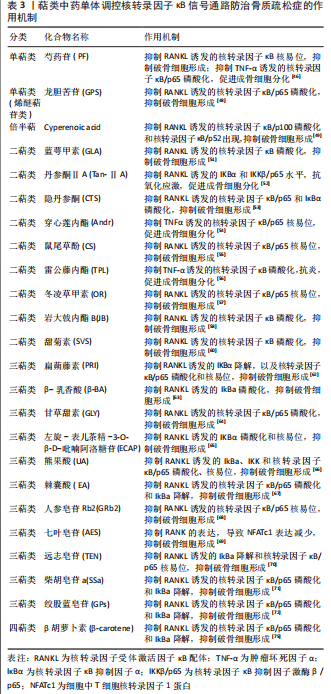
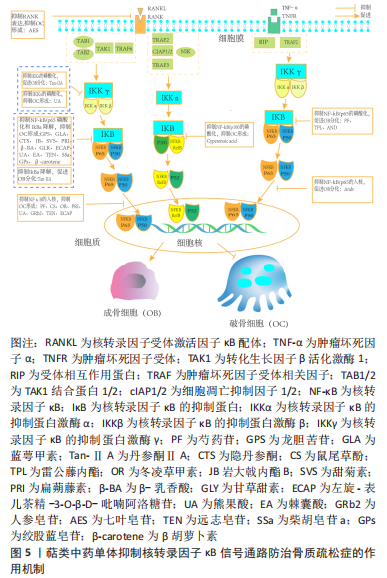
| [1] IOLASCON G, DE SIRE A, CURCI C, et al. Osteoporosis guidelines from a rehabilitation perspective: systematic analysis and quality appraisal using AGREE II. Eur J Phys Rehabil Med. 2021;57(2):273-279. [2] ZOU Z, LIU W, CAO L, et al. Advances in the occurrence and biotherapy of osteoporosis. Biochem Soc Trans. 2020;48(4):1623-1636. [3] NOH JY, YANG Y, JUNG H. Molecular mechanisms and emerging therapeutics for osteoporosis. Int J Mol Sci. 2020;21(20):7623. [4] SHEN Y, HUANG X, WU J, et al. The global burden of osteoporosis, low bone mass, and its related fracture in 204 countries and territories, 1990-2019. Front Endocrinol (Lausanne). 2022;13:882241. [5] 中国骨质疏松症流行病学调查及“健康骨骼”专项行动结果发布[J].中华骨质疏松和骨矿盐疾病杂,2019,12(4):317-318. [6] 朱洁云,高敏,宋秋韵,等.中国老年人骨质疏松症患病率的Meta分析[J].中国全科医学,2022,25(3):346-353. [7] 文学,孙红,王洪,等.PTHrP类似物阿巴洛肽在骨质疏松症中的研究进展[J].中华老年骨科与康复电子杂志,2021,7(2):117-121. [8] ZHUO Y, LI M, JIANG Q, et al. Evolving roles of natural terpenoids from traditional chinese medicine in the treatment of osteoporosis. Front Endocrinol (Lausanne). 2022;13:901545. [9] CAPECE D, VERZELLA D, FLATI I, et al. NF-κB: blending metabolism, immunity, and inflammation. Trends Immunol. 2022;43(9):757-775. [10] SEN R, BALTIMORE D. Multiple nuclear factors interact with the immunoglobulin enhancer sequences. Cell. 1986;46(5):705-716. [11] FRANZOSO G, CARLSON L, XING L, et al. Requirement for NF-kappaB in osteoclast and B-cell development. Genes Dev. 1997;11(24):3482-3496. [12] ALI NN, GILSTON V, WINYARD PG. Activation of NF-kappaB in human osteoblasts by stimulators of bone resorption. FEBS Lett. 1999;460(2):315-320. [13] KASAMA T, ISOZAKI T, ODAI T, et al. Expression of angiopoietin-1 in osteoblasts and its inhibition by tumor necrosis factor-alpha and interferon-gamma. Transl Res. 2007;149(5):265-273. [14] ZHEN R, YANG J, WANG Y, et al. Hepatocyte growth factor improves bone regeneration via the bone morphogenetic protein2mediated NFκB signaling pathway. Mol Med Rep. 2018;17(4):6045-6053. [15] PENG Y, LV S, LI Y, et al. Glucocorticoids disrupt skeletal angiogenesis through transrepression of NF-κB-mediated preosteoclast Pdgfb transcription in young mice. J Bone Miner Res. 2020;35(6):1188-1202. [16] POMA P. NF-κB and Disease. Int J Mol Sci. 2020;21(23):9181. [17] YU H, LIN L, ZHANG Z, et al. Targeting NF-κB pathway for the therapy of diseases:mechanism and clinical study. Signal Transduct Target Ther. 2020;5(1):209. [18] THOMS HC, STARK LA. The NF-κB nucleolar stress response pathway. Biomedicines. 2021;9(9):1082. [19] MULERO MC, HUXFORD T, GHOSH G. NF-κB, IκB, and IKK: integral components of immune system signaling. Adv Exp Med Biol. 2019;1172:207-226. [20] LU RJ, XING HL, LIU CJ, et al. Antibacterial peptides inhibit MC3T3-E1 cells apoptosis induced by TNF-αthrough p38 MAPK pathway. Ann Transl Med. 2020;8(15):943. [21] REMMERS SJA, YAN DER HEIJDEN FC, DE WILDT BWM, et al. Tuning the resorption-formation balance in an in vitro 3D osteoblast-osteoclast co-culture model of bone. Bone Rep. 2022;18:101646. [22] MISHRA R, SEHRING I, CEDERLUND M, et al. NF-κB signaling negatively regulates osteoblast dedifferentiation during zebrafish bone regeneration. Dev Cell. 2020;52(2):167-182. [23] HE YQ, YANG H, SHEN Y, et al. Monotropein attenuates ovariectomy and LPS-induced bone loss in mice and decreases inflammatory impairment on osteoblast through blocking activation of NF-κB pathway. Chem Biol Interact. 2018;291:128-136. [24] LIANG X, LI B, HUANG Q, et al. Klotho prevents DEX-induced apoptosis in MC3T3-E1 osteoblasts through the NF-κB signaling pathway. Biochem Biophys Res Commun. 2018;507(1-4):355-361. [25] QUYANG X, LI S, DING Y. et al. Foxf1 gene increases the risk of osteoporosis in rats by inhibiting osteoblast formation and promoting osteoclast differentiation through the upregulation of NF-κB pathway. J Musculoskelet Neuronal Interact. 2022;22(2):242-250. [26] TIAN H, CHEN F, WANG Y, et al. Nur77 prevents osteoporosis by inhibiting the nf-κb signalling pathway and osteoclast differentiation. J Cell Mol Med. 2022;26(8):2163-2176. [27] ZHUANG Q, CHEN S, ZHANG W, et al. Avicularin alleviates osteoporosis in ovariectomized mice by inhibiting osteoclastogenesis through NF-κB pathway inhibition. J Agric Food Chem. 2022. doi: 1021.2/acs.jafc.05954. [28] KIM B, LEE KW, PARK B. Icariin abrogates osteoclast formation through the regulation of the RANKL-mediated TRAF6/NF-κB/ERK signaling pathway in Raw264. 7 cells. Phytomedicine. 2018;51:181-190. [29] SWARNKAR G, CHEN TH, ARRA M, et al. NUMBL interacts with TAK1, TRAF6 and NEMO to negatively regulate NF-κB signaling during osteoclastogenesis. Sci Rep. 2017;7(1):12600. [30] XU J, WU HF, ANG ES, et al. NF-kappaB modulators in osteolytic bone diseases. Cytokine Growth Factor Rev. 2009;20(1):7-17. [31] DONG M, ZENG J, YANG C, et al. Asiatic acid attenuates osteoporotic bone loss in ovariectomized mice through inhibiting NF-kappaB/MAPK/Protein Kinase B signaling pathway. Front Pharmacol. 2022;13:829741. [32] ZHANG F, HUANG X, QI Y, et al. Juglanin inhibits osteoclastogenesis in ovariectomized mice via the suppression of NF-κB signaling pathways. Front Pharmacol. 2021;11:596230. [33] SHEN G, LIUI X, LEI W, et al. Plumbagin is a NF-κB-inducing kinase inhibitor with dual anabolic and antiresorptive effects that prevents menopausal-related osteoporosis in mice. J Biol Chem. 2022;298(4):101767. [34] AVNET S, CHANO T, MASSA A, et al. Acid microenvironment promotes cell survival of human bone sarcoma through the activation of cIAP proteins and NF-κB pathway. Am J Cancer Res. 2019;9(6):1127-1144. [35] YAO Z, LEI W, DUAN R, et al. RANKL cytokine enhances TNF-induced osteoclastogenesis independently of TNF receptor associated factor (TRAF) 6 by degrading TRAF3 in osteoclast precursors. J Biol Chem. 2017;292(24):10169-10179. [36] WANG W, WANG B. Expression of angiogenesis-related proteins in bone marrow mesenchymal stem cells induced by osteoprotegerin during osteogenic differentiation in rats. Int Immunopharmacol. 2021;98:107821. [37] FAN D, LU J, YU N, et al. Curcumin prevents diabetic osteoporosis through promoting osteogenesis and angiogenesis coupling via NF-κB signaling. Evid Based Complement Alternat Med. 2022;2022:4974343. [38] LIN X, XU F, ZHANG KW, et al. Acacetin prevents bone loss by disrupting osteoclast formation and promoting type H vessel formation in ovariectomy-induced osteoporosis. Front Cell Dev Biol. 2022;10:796227. [39] 张杰,董万涛,赵宝宝,等.中医药干预骨质疏松成血管-成骨耦联因子研究进展[J].中国骨质疏松杂,2023,29(1):151-156. [40] KANWAL A, BILAL M, RASOOL N, et al. Total synthesis of terpenes and their biological significance: a critical review. Pharmaceuticals (Basel). 2022;15(11):1392. [41] NINKUU V, ZHANG L, YANG J, et al. Biochemistry of terpenes and recent advances in plant protection. Int J Mol Sci. 2021;22(11):5710. [42] BELLAVIA D, CARADONNA F, DIMARCO E, et al. Terpenoid treatment in osteoporosis: this is where we have come in research. Trends Endocrinol Metab. 2021;32(11):846-861. [43] GAO Y, WANG T, WANNG G, et al. Preclinical safety of ginsenoside compound K: acute, and 26-week oral toxicity studies in mice and rats. Food Chem Toxicol. 2019;131: 110578. [44] NURCAHYANTI ADR, SATRIAWAN N, SHAROPOV F. Free radical scavenging synergism of fucoxanthin with lipophilic plant products. Nat Prod Res. 2023;37(5):782-787. [45] ZOU L, DING W, HUANG Q, et al. Andrographolide/phospholipid/cyclodextrin complex-loaded nanoemulsion: preparation, optimization, in vitro and in vivo evaluation. Biol Pharm Bull. 2022;45(8):1106-1115. [46] WANG Y,DAI J, ZHU Y, et al. Paeoniflorin regulates osteoclastogenesis and osteoblastogenesis via manipulating NF-κB signaling pathway both in vitro and in vivo. Oncotarget. 2017;9(7):7372-7388. [47] JIN M, FENG H, WANG Y, et al. Gentiopicroside ameliorates oxidative stress and lipid accumulation through nuclear factor erythroid 2-related factor 2 activation. Oxid Med Cell Longev. 2020;2020:2940746. [48] CHEN F, XIE L, KANG R, et al. Gentiopicroside inhibits RANKL-induced osteoclastogenesis by regulating NF-κB and JNK signaling pathways. Biomed Pharmacother. 2018;100: 142-146. [49] CHAWALITPONG S, CHOKCHAISIRI R, SUKSAMRAM A, et al. Cyperenoic acid suppresses osteoclast differentiation and delays bone loss in a senile osteoporosis mouse model by inhibiting non-canonical NF-κB pathway. Sci Rep. 2018;8(1):5625. [50] 徐硕,姜文清,吴学军,等.中药中二萜类化学成分分析方法的研究进展[J].西北药学杂志,2020,35(5):788-791. [51] ZHU M, SHAN J, XU H, et al. Glaucocalyxin A suppresses osteoclastogenesis induced by RANKL and osteoporosis induced by ovariectomy by inhibiting the NF-κB and Akt pathways. J Ethnopharmacol. 2021;276:114176. [52] ZHU S, WEI W, LIU Z, et al. Tanshinone IIA attenuates the deleterious effects of oxidative stress in osteoporosis through the NFκB signaling pathway. Mol Med Rep. 2018;17(5):6969-6976. [53] WANG W, HUANG M, HUI Y, et al. Cryptotanshinone inhibits RANKL-induced osteoclastogenesis by regulating ERK and NF-κB signaling pathways. J Cell Biochem. 2019;120(5):7333-7340. [54] 丁丁,车千红,徐樱溪,等.穿心莲内酯通过抑制TNF-α活化的核转录因子κB信号途径保护和促进成骨分化[J].解剖科学进展,2019,25(3):316-319,334. [55] 李婧,程梁,郭吕华,等.银杏叶中异鼠李素对RAW264.7细胞向破骨细胞分化的影响及其分子机制[J].口腔疾病防治,2018,26(3):158-165. [56] LIU SP, WANG GD, DU XJ, et al. Triptolide inhibits the function of TNF-αin osteoblast differentiation by inhibiting the NF-κB signaling pathway. Exp Ther Med. 2017;14(3): 2235-2240. [57] XIE Z, YU H, SUN X, et al. A novel diterpenoid suppresses osteoclastogenesis and promotes osteogenesis by inhibiting ifrd1-mediated and IκBα-mediated p65 nuclear translocation. J Bone Miner Res. 2018;33(4):667-678. [58] MA X, LIU Y, ZHANG Y, et al. Jolkinolide B inhibits RANKL-induced osteoclastogenesis by suppressing the activation NF-κB and MAPK signaling pathways. Biochem Biophys Res Commun. 2014;445(2):282-288. [59] BAI Q, WANG X, MAO X, et al. Aldo-keto reductase 1 member B1(AKR1B1)inhibits retinal ganglion cell activity via activating NF-κB pathway and inducing mouse BV-2 microglia activation. Xi Bao Yu Fen Zi Mian Yi Xue Za Zhi. 2020;36(12):1063-1068. [60] 陈莎,周佳瑛,储非凡,等.甜菊素对RANKL诱导的破骨细胞分化和功能的影响[J].中成药,2022,44(6):1804-1809. [61] LIU S, LIU H, ZHANG L, et al. Edible pentacyclic triterpenes: a review of their sources, bioactivities, bioavailability, self-assembly behavior, and emerging applications as functional delivery vehicles. Crit Rev Food Sci Nutr. 2022. doi: 1080.10408398/2022.2153238.36476115. [62] LI X, LIN X, WU Z, et al. Pristimerin protects against OVX-mediated bone loss by attenuating osteoclast formation and activity via inhibition of RANKL-mediated activation of NF-κB and ERK signaling pathways. Drug Des Devel Ther. 2021;15:61-74. [63] PARK GD, CHEON YH, EUN SY, et al. β-boswellic acid inhibits RANKL-induced osteoclast differentiation and function by attenuating NF-κB and Btk-PLCγ2 signaling pathways. Molecules. 2021;26(9):2665. [64] TANG Y, LV XL, BAO YZ, et al. Glycyrrhizin improves bone metabolism inovariectomized mice via inactivating NF-κB signaling. Climacteric. 2021;24(3):253-260. [65] HSIAO HB, WU JB, LIN WC. (-)-Epicatechin 3-O-β-D-allopyranoside prevent ovariectomy-induced bone loss in mice by suppressing RANKL-induced NF-κB and NFATc1 signaling pathways. BMC Complement Altern Med. 2017;17(1):245. [66] JIANG C, XIAO F, GU X, et al. Inhibitory effects of ursolic acid on osteoclastogenesis and titanium particle-induced osteolysis are mediated primarily via suppression of NF-κB signaling. Biochimie. 2015;111:107-18. [67] YANG JH, LI B, WU Q, et al. Echinocystic acid inhibits RANKL-induced osteoclastogenesis by regulating NF-κB and ERK signaling pathways. Biochem Biophys Res Commun. 2016; 477(4):673-677. [68] 柳嘉伟,苏柯,黄鑫,等.人参皂苷Rb2体内抑制破骨细胞的作用及其机制研究[J].中国骨与关节杂志,2020,9(4):293-298. [69] ZHAO XL, CHEN LF, WANG Z. Aesculin modulates bone metabolism by suppressing receptor activator of NF-κB ligand (RANKL)-induced osteoclastogenesis and transduction signals. Biochem Biophys Res Commun. 2017;488(1):15-21. [70] YANG S, LI X, CHENG L, et al. Tenuigenin inhibits RANKL-induced osteoclastogenesis by down-regulating NF-κB activation and suppresses bone loss in vivo. Biochem Biophys Res Commun. 2015;466(4):615-621. [71] ZHOU C, LIU W, HE W, et al. Saikosaponin a inhibits RANKL-induced osteoclastogenesis by suppressing NF-κB and MAPK pathways. Int Immunopharmacol. 2015;25(1):49-54. [72] HAN J, GAO W, SU D, et al. Gypenoside inhibits RANKL-induced osteoclastogenesis by regulating NF-κB, AKT, and MAPK signaling pathways. J Cell Biochem. 2018;119(9):7310-7318. [73] MAOKA T. Carotenoids as natural functional pigments. J Nat Med. 2020;74:1-16. [74] GAO SS, ZHAO Y. The effects ofβ-carotene on osteoporosis:a systematic review and meta-analysis of observational studies. Osteoporos Int. 2022. doi: 1007.00198/s022-06593-7-36380163. [75] WANG F, WANG N, GAO Y, et al. β-Carotene suppresses osteoclastogenesis and bone resorption by suppressing NF-κB signaling pathway. Life Sci. 2017;174:15-20. |
| [1] | 杨玉芳, 杨芷姗, 段棉棉, 刘毅恒, 唐正龙, 王 宇. 促红细胞生成素在骨组织工程中的应用及前景[J]. 中国组织工程研究, 2024, 28(9): 1443-1449. |
| [2] | 杨毅峰, 叶 楠, 王 琳, 郭帅成, 黄 健. 右美托咪定抗缺血再灌注损伤的信号通路[J]. 中国组织工程研究, 2024, 28(9): 1464-1469. |
| [3] | 黄浩然, 凡一诺, 卫杨文祥, 江梦钰, 方汉军, 王海彬, 陈镇秋, 刘予豪, 周 驰. 尿石素A介导p38/MAPK通路抑制破骨细胞活性[J]. 中国组织工程研究, 2024, 28(8): 1149-1154. |
| [4] | 章晓云, 刘 桦, 柴 源, 陈 锋, 曾 浩, 高振罡, 黄有荣. 益肾固疏方干预老年性骨质疏松症患者骨代谢标志物的变化及临床疗效[J]. 中国组织工程研究, 2024, 28(8): 1155-1160. |
| [5] | 岳 云, 王佩佩, 袁兆鹤, 何生存, 贾戌生, 刘 倩, 李占涛, 付慧玲, 宋 斐, 贾孟辉. 巴豆霜干预脑缺血再灌注损伤大鼠皮质区JNK/p38 MAPK及神经元凋亡的机制[J]. 中国组织工程研究, 2024, 28(8): 1186-1192. |
| [6] | 代越星, 郑利钦, 吴敏辉, 李志鸿, 李少彬, 郑德声, 林梓凌. 血管数量对小血管网计算流体力学的影响[J]. 中国组织工程研究, 2024, 28(8): 1206-1210. |
| [7] | 刘 鑫, 胡 满, 赵文杰, 张 钰, 孟 博, 杨 盛, 彭 晴, 张 亮, 王静成. 镉暴露激活PI3K/Akt信号通路诱导椎间盘纤维环细胞衰老[J]. 中国组织工程研究, 2024, 28(8): 1217-1222. |
| [8] | 魏 娟, 李 婷, 郇梦婷, 谢 颖, 谢舟煜, 韦庆波, 吴云川. 静力性训练改善2型糖尿病骨骼肌胰岛素抵抗的机制[J]. 中国组织工程研究, 2024, 28(8): 1271-1276. |
| [9] | 刘建宏, 廖世杰, 李波香, 唐生平, 韦帧翟, 丁晓飞. 细胞外囊泡携带非编码RNA调控破骨细胞的活化[J]. 中国组织工程研究, 2024, 28(7): 1076-1082. |
| [10] | 潘小龙, 樊飞燕, 应春苗, 刘飞祥, 张运克. 中药抑制间充质干细胞衰老的作用及机制[J]. 中国组织工程研究, 2024, 28(7): 1091-1098. |
| [11] | 王 雯, 郑芃芃, 孟浩浩, 刘 浩, 袁长永. 过表达Sema3A促进牙髓干细胞和MC3T3-E1的成骨分化[J]. 中国组织工程研究, 2024, 28(7): 993-999. |
| [12] | 凯依塞尔•阿布都克力木, 麦麦提敏•阿卜力米提, 李 磊, 杨晓凯, 张玉坤, 刘 帅. 女性腰椎退行性病变患者腰椎CT值对骨质疏松症的诊断作用[J]. 中国组织工程研究, 2024, 28(6): 945-949. |
| [13] | 王力平, 连天星, 胡永荣, 杨红胜, 曾智谋, 刘 浩, 屈 波. 胸部CT椎体HU值在2型糖尿病骨质疏松症机会性筛查中的价值[J]. 中国组织工程研究, 2024, 28(6): 950-954. |
| [14] | 张克凡, 石 辉. 细胞因子治疗骨关节炎的研究现状及应用前景[J]. 中国组织工程研究, 2024, 28(6): 961-967. |
| [15] | 张 娅, 牟秋菊, 王自林, 刘宏杰, 祝丽丽. 负载富血小板血浆的水凝胶促进糖尿病大鼠创面愈合[J]. 中国组织工程研究, 2024, 28(5): 690-696. |
目前临床上使用的双膦酸盐、钙补充剂、降钙素和维生素D等治疗骨质疏松症的西医药物,大多数都存在着不良反应多、疗效不一、患者耐受能力差等不足之处[7]。中医是从人是一个统一的整体、辨证施治的思维入手,从整体上调节机体的功能,促进骨吸收与骨生成的动态平衡,从而提高机体的生物力学性能。中药作为中医治疗的特色,在防治骨质疏松症上具有悠久的历史。来源于中药的萜类化合物应用前景非常广泛,研究表明萜类化合物可以通过多种途径促进骨细胞增殖和分化,促进骨基质沉积和骨矿化,在骨组织工程中发挥着重要作用[8]。
核转录因子κB是一种在哺乳类动物细胞内发现的转录因子,它能够快速地对外界的各种刺激做出反应,进而调控相关靶基因的表达介导细胞氧化应激、细胞凋亡、增殖及炎症反应等生物学过程[9]。随着细胞与组织工程学研究的不断深入,研究者基于体外细胞实验和动物模型,发现核转录因子κB信号通路在骨代谢中发挥着重要的作用,在正常情况下,激活核转录因子κB信号通路具有促进血管生成、骨吸收和骨重建,抑制炎症反应等作用,从而维持骨代谢的平衡。但是,在骨质疏松症患者中,核转录因子κB信号通路会过度激活,进而造成血管生成减少、骨吸收增加、骨形态改变和骨量减少等不良影响。
以往在核转录因子κB信号通路与骨质疏松症相关的综述中,尚缺乏“血管生成-成骨”偶联与核转录因子κB信号通路关系的总结,以及对萜类中药单体化合物调控核转录因子κB信号通路,进而防治骨质疏松症的研究进行归纳。为此,文章从萜类中药单体化合物调控核转录因子κB信号通路防治骨质疏松症的作用机制角度出发,对相关的文献资料进行整理、分析和总结,阐述核转录因子κB信号通路调控血管生成、成骨细胞分化、破骨细胞形成进而防治骨质疏松症的机制,并对萜类中药单体化合物调控核转录因子κB信号通路防治骨质疏松症的分子机制和研究进展进行系统性综述,为今后骨质疏松症治疗药物的研制和开发奠定基础。 中国组织工程研究杂志出版内容重点:组织构建;骨细胞;软骨细胞;细胞培养;成纤维细胞;血管内皮细胞;骨质疏松;组织工程
1.1.1 检索人及检索时间 由2名研究员在2022年12月根据制定的标准进行检索,再通过第3名研究员对文献进行汇总和整理。
1.1.2 检索文献时限 各数据库建库至2022年12月发表的文献。
1.1.3 检索数据库 中国知网和PubMed数据库。
1.1.4 检索词 中文检索词以“NF-κB、骨质疏松症,成骨细胞,破骨细胞,血管生成,中药,萜类化合物”等检索中国知网数据库;英文检索词以“NF-κB,osteoporosis,Osteoblasts,Osteoclasts,Angiogenesis,traditional Chinese medicine,terpenoid”检索PubMed数据库。
1.1.5 检索文献类型 研究原著、基础实验和综述。
1.1.6 手工检索情况 无。
1.1.7 检索策略 中英文数据库检索策略见图1。
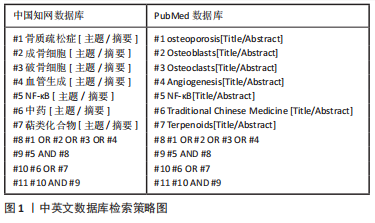
5 926篇,中国知网数据库67篇。
1.2 入组标准
1.2.1 纳入标准 ①涉及核转录因子κB信号通路与成骨细胞、破骨细胞及血管生成相关的研究;②涉及核转录因子κB信号通路防治骨质疏松症的细胞实验和动物生物学研究;③涉及萜类化合物调控核转录因子κB信号通路防治骨质疏松症的研究。
1.2.2 排除标准 ①不符合纳入标准,重复发表的文章;②无法获取完整数据和资料的研究;③硕士及博士毕业论文以及会议文献。
1.3 文献质量评估和数据提取 初步检索两大数据库共获得5 993篇相关文献,其中PubMed 数据库5 926篇,中国知网67篇。根据阅读文章标题及摘要,进行二次筛选,排除研究目的不相符、重复报道及硕士、博士毕业论文以及会议文献,筛选出382篇文献。详细查阅文献内容后进行归纳和总结,最终纳入75篇文献进行系统性综述,其中PubMed 数据库66篇,中国知网数据库9篇。文献检索流程图见图2。
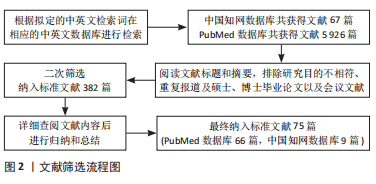
3.2 综述的特点 文章鉴于以往核转录因子κB信号通路与骨质疏松相关的综述,发现尚缺乏对“血管-成骨”偶联与核转录因子κB信号通路关系的总结,以及萜类中药单体化合物虽然已被证明可以通过调控核转录因子κB信号通路,促进成骨细胞分化,抑制破骨细胞形成,起到防治骨质疏松的作用,但是目前尚缺乏这方面的研究综述。因此,文章阐述核转录因子κB信号通路调控血管生成、成骨细胞分化、破骨细胞形成进而防治骨质疏松的机制,并对萜类中药单体化合物调控核转录因子κB信号通路防治骨质疏松的分子机制和研究进展进行系统性综述。
3.3 综述的不足之处 ①文章仅检索了中国知网和PubMed两个数据库,不可避免会出现部分研究疏漏;②文章重点总结了萜类中药单体单体化合物调控核转录因子κB信号通路防治骨质疏松症的研究进展,对于其他类型的化合物,如黄酮类及生物碱类等化合物未涉及。③关于核转录因子κB信号通路调控“血管-成骨”偶联的研究,现阶段的基础研究较少,故此方面的综述较局限。
3.4 综述的重要意义 骨质疏松症在全球范围内广泛存在,严重影响了老年人的生活质量和寿命。目前临床上大多数西药都存在着不良反应多、疗效不一及患者耐受能力差等不足之处。中药作为中医治疗的特色,在防治骨质疏松上具有悠久的历史。来源于中药的萜类化合物应用前景非常广泛,其可以通过抑制IkBa降解,阻断核转录因子κB/p65磷酸化、核转位等过程,进而减弱核转录因子κB信号通路的传导,促进成骨细胞分化,抑制破骨细胞形成,起到防治骨质疏松的作用。因此文章对萜类中药单体化合物调控核转录因子κB信号通路防治骨质疏松的分子机制和研究进展进行系统性综述,为今后骨质疏松治疗药物的研制和开发奠定基础。 中国组织工程研究杂志出版内容重点:组织构建;骨细胞;软骨细胞;细胞培养;成纤维细胞;血管内皮细胞;骨质疏松;组织工程
 #br#
#br#
文题释义:
骨质疏松症:是以骨量减少、骨微结构损害导致骨脆性增加的代谢性骨病,其发病机制复杂,多由胃肠道疾病、糖尿病、类风湿性关节炎、衰老、长期使用糖皮质激素治疗、多发性骨髓瘤和其他血液疾病发展而来。核转录因子κB信号通路:该通路能够快速地对外界的各种刺激做出反应,进而调控相关靶基因的表达介导细胞氧化应激、细胞死亡、增殖及炎症反应等生物学过程。目前,已有研究证实核转录因子κB信号通路与骨质疏松症具有紧密的联系,能有效维持人体的骨稳态。
骨质疏松症是以骨量减少、骨组织微结构异常导致骨矿密度降低的代谢性骨病。其发病机制复杂,多由炎症、胃肠道疾病、糖尿病、衰老、长期接受糖皮质激素治疗、多发性骨髓瘤和其他血液疾病发展而来。其中炎症和骨质疏松症研究较为广泛,两者在生理和病理过程中相互影响,炎症可引发骨质疏松的发展和进展,导致骨质量减少和骨结构损失,而骨质疏松则可能加重炎症的产生和发展,形成一种双向的关联。相关数据显示,在骨质疏松症导致的死亡和残疾数量方面,中国在全球204个国家中排名第二,这与骨质疏松症相关的防治知识普及密切相关,数据显示中国农村地区人群因缺乏相关防治知识,患骨质疏松症的比例相对较高。因此,很多骨质疏松症患者在疾病早期就延误治疗,导致生活质量下降,又因骨质疏松症具有高死亡率、高残疾率的特点,给患者及整个社会都造成了巨大的经济重压。
| 阅读次数 | ||||||
|
全文 |
|
|||||
|
摘要 |
|
|||||